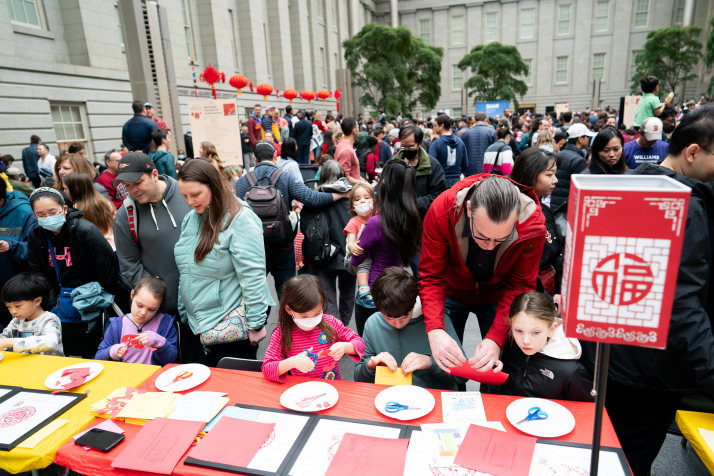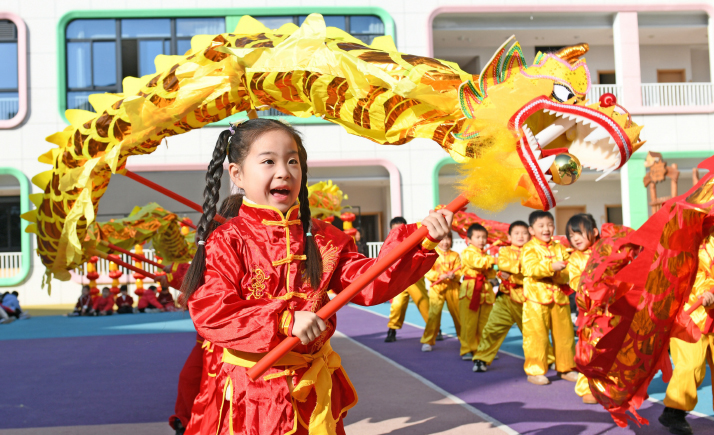| China |
| The most important Chinese traditional festival gains global recognition | |
|
|
 Families enjoy a hands-on experience with traditional Chinese papercutting during a Spring Festival-themed event at the Smithsonian American Art Museum in Washington, D.C., the United States, on February 16 (XINHUA)
The Spring Festival, the oldest and most important traditional festival in Chinese culture, has been added to the United Nations Educational, Scientific and Cultural Organization (UNESCO) heritage list. On December 4, UNESCO announced its recognition of the Spring Festival, social practices celebrated by the Chinese people during the traditional lunisolar New Year, as an Intangible Cultural Heritage of Humanity during the 19th Session of the Intergovernmental Committee for Safeguarding Intangible Cultural Heritage in Asunción, Paraguay.
With this latest addition, China now boasts 44 cultural elements or practices on the UNESCO Intangible Cultural Heritage list, the highest number in the world. According to Xiao Fang, head of the Department of Anthropology and Folklore Studies at Beijing Normal University, the inclusion of the Spring Festival on the list reflects global recognition and respect for traditional culture. "It is a jubilant time for Chinese people, and China is also generous in sharing its excellent traditional culture with people around the world," Xiao told newspaper People's Daily.  Kindergarten children perform a dragon dance to welcome the arrival of the Spring Festival of the Year of the Dragon in Taizhou City, Zhejiang Province, on January 18 (XINHUA)
Tradition and renewal Marking the arrival of spring and the start of the lunisolar new year, the Spring Festival, also known as Chinese New Year, is rich in traditions and customs. It brings families together, honors ancestors and sets the tone for the year ahead. The origins of the Spring Festival can be traced back over 2,000 years to ancient agricultural practices. It was originally a celebration of the harvest and a way to honor deities and ancestors. Over the centuries, the festival has evolved, incorporating many regional customs, but its core themes of renewal, family reunion and good fortune remain unchanged. The festival is celebrated with a plethora of traditional practices that vary across regions in China. One of the most prominent customs is the reunion dinner on New Year's Eve, when families gather to enjoy a lavish meal featuring symbolic dishes such as fish (for abundance) and dumplings (for wealth). Children receive red envelopes filled with money, known as hongbao, as a symbol of good fortune and prosperity. Today, with many people working in different cities far from their hometowns, the Spring Festival triggers a massive travel rush. This annual migration, known as chunyun, sees hundreds of millions of people journeying back to their families to celebrate the holiday together. As the largest population migration in the world, it involves all modes of transportation—trains, buses and planes—often resulting in crowded stations and airports. Despite the challenges of travel, the joy of getting together with family members and partaking in the rich festival customs makes the journey worthwhile for many, although in recent years, some people instead explore new travel destinations during the holiday. In the days leading up to the Chinese New Year, homes are cleaned and decorated with items believed to bring good luck, including red lanterns, papercuttings and spring couplets—two lines of matching poetry written on red paper banners affixed to either side of a home or building's front door. The color red symbolizes happiness and warding off evil spirits. The Spring Festival lasts for 15 days, culminating in the Lantern Festival, during which families display lanterns and enjoy a traditional sweet dish of glutinous rice balls. This vibrant display of lights symbolizes the hope for a bright future. The box office often experiences a significant boom during the Spring Festival, with many families flocking to theaters to enjoy new movies together. This festive period is one of the most lucrative times for the film industry in China, as studios strategically release highly anticipated films. Comedy films are particularly popular during this time. Incorporated with themes of family, reunion and celebration, they are especially appealing to audiences looking for uplifting content. The holiday's box office revenue this year reached 8.02 billion yuan ($1.1 billion) between February 10 and 17, with 163 million tickets sold, according to statistics from the China Film Administration. Joys shared The Spring Festival is not just a Chinese festival but a global one, with nearly 20 countries have designated the first day of the first month of the traditional Chinese calendar as a public holiday, with about one fifth of the world's population participating in various forms of celebration, according to Chinese Foreign Ministry spokesperson Lin Jian. Through vivacious parades, culinary fairs and workshops on Chinese crafts, the festival draws people from all segments of society to experience its inclusive and festive spirit. "From Southeast Asia to Europe, not only overseas Chinese, but also an increasing number of local people consider the Spring Festival as their own festival. They also integrate local culture into the festive activities of the Spring Festival," said Zhang Bo, Deputy Secretary General of the China Folklore Society. "China has cultural policies worthy of recognition," Nancy Ovelar de Gorostiaga, Paraguay's permanent representative to UNESCO and chair of the session, told Xinhua News Agency. "China is always present in cultural movements and is visible, so we value that and believe that it is the example that many countries should follow in order to try to safeguard their heritage, culture and traditions." Zheng Changling, a researcher at the Chinese Academy of Cultural Studies said in the face of today's rapidly developing and highly materialistic society, relationships between people can sometimes become very tense, and in this state, people need the Spring Festival as a holiday for family reunion and universal celebration. "The charm of the Spring Festival is reflected here. It is not only a day for reunion with family and friends, but also a manifestation of shared human values," he told newspaper Global Times. "In about six weeks, we will celebrate the Spring Festival of the Year of the Snake. We welcome all journalists here and friends from all over the world to come and experience the rich and wonderful Spring Festival culture. We very much hope that the festival's cultural message will contribute to a world of fewer conflicts, harmony among civilizations, and amity between peoples of the world. Hope the Spring Festival will be a moment of joyfulness shared by all," Lin said at a press conference on December 5. (Print Edition Title: Springing Into History!) Copyedited by G.P. Wilson Comments to luyan@cicgamericas.com |
|
||||||||||||||||||||||||||||||
|